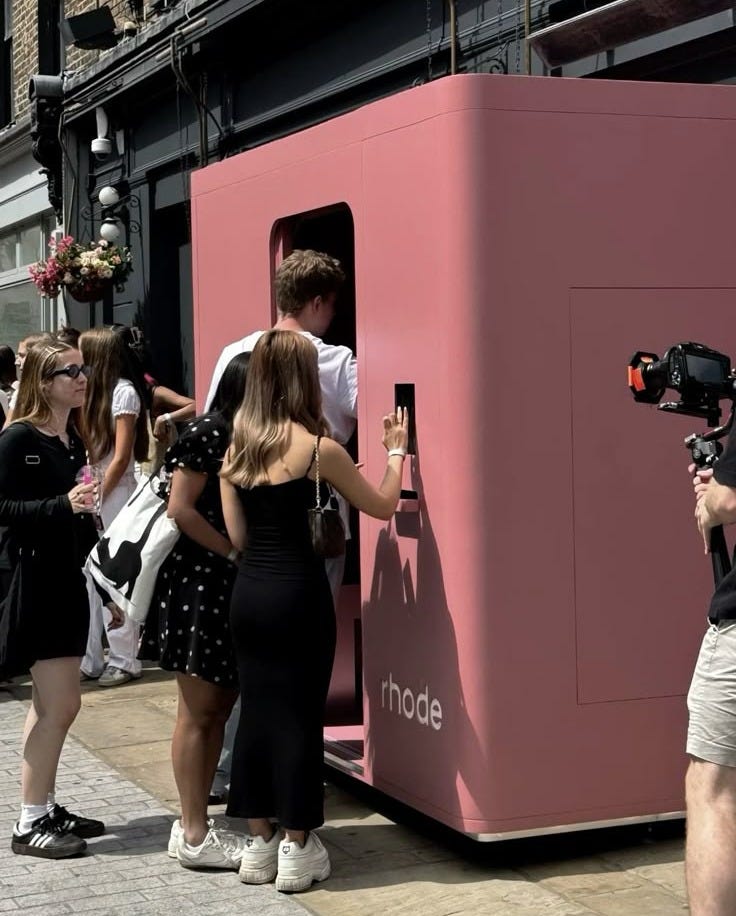ANOTHER DAY
ANOTHER STARTUP INSIGHT
Whenever you're ready, there are 4 ways I can help you:
1. Promote your business to 1,000+ readers:
Put your business in front of 1,000+ highly-engaged founders, operators, investors, and potential early users at a 35% open rate!
2. Get featured in What A Startup:
Let us tell your story. We’ll write a founder-first feature that highlights your startup journey, traction, and insights — then share it with 1000+ of early-stage founders, builders, and investors.
3. Book a 1-on-1 coaching session with Gracie:
In one hour, let's help you get unstuck and map out an actionable plan to acquire your first 100-1000 customers fast.
4. Get warm intro to 100+ investors and VCs:
I’ll personally introduce you to early-stage investors who are active, founder-friendly, and aligned with your vision — no cold outreach, just real conversations that move things forward.Most founders think they need to “go big or go home.”
They obsess over …
hitting a million users
hitting a $10M ARR
or raising a $5M seed round
But what if I told you that to build a profitable, fulfilling, sustainable startup — you don’t need millions of users, dollars, subscribers or downloads?
You just need 1,000 true fans.
YES, exactly 1,000 people who deeply care and genuinely love you.
Why 1,000 true fans?
In 2008, Kevin Kelly published an iconic essay called 1,000 True Fans. It was about how artists, creators, and entrepreneurs didn’t need mass-market fame — just a direct, loyal relationship with a small group of super fans.
That idea still holds true.
The fact is that:
You don’t even need 1,000 true fans to start.
You need 100 people who believe in your vision before it’s even “good.”
Those early 100 believers become your:
Early users
Your beta testers
Your evangelists
Your feedback loop
Your distribution channel
Your moat
Again…
Not just passive subscribers or casual users.
I’m talking about super fans.
People who:
Use your product even when it’s buggy
Tell their friends about you unprompted
Give raw feedback because they want you to win
Say, “I’m rooting for this founder” — not just, “cool app”
Why this is the founder’s shortcut
The common path founders chase:
Build → Launch → Pay for ads → Try to convert strangers
The smarter (and saner) path:
Share → Connect → Build with your believers → Let them market for you
When you have just 100 true fans in the early stage:
You don’t need to “sell” — they already trust you
You don’t need to guess what to build — they’ll tell you
You don’t burn out trying to reach strangers — you double down on connection
And gradually, those 100 true fans will grow into 1,000 super fans
This is community as emotional infrastructure.
This is marketing without selling.
This is how distribution becomes built in, not bolted on.
This matters for startup founders
Most founders focus on scale too early:
How do we get traffic?
What’s our CAC?
How do we go viral on LinkedIn?
Those are good questions — but they’re the wrong first questions.
Here’s what actually matters early on:
“Do 5 people love this?”
“Would 10 people be disappointed if this disappeared?”
“Would 25 people recommend this without being asked?”
Because if the answer is yes …
You’ve found signal.
And signal scales.
But why this works
Let’s break down why the 1,000 true fans model works so well — especially today:
You can go direct-to-user.
Thanks to platforms like Substack, Gumroad, Stripe, Discord, and Patreon — you don’t need VCs, publishers, or App Store gatekeepers. You keep more of the money.The internet shrinks the world.
A weird little idea that might appeal to 1 in every 100,000 people… can still get 1,000 buyers across the globe. Niches are no longer small when the internet is your reach.True fans = your growth engine.
They’ll refer, repost, and rave. You don’t need a paid ads budget when your fans want to bring others into the fold.Community becomes your moat.
These 1,000 fans aren’t just customers — they’re your early community. They give feedback, co-create, and make churn less likely.
Let’s do some math
If your product generates:
$10/month from each true fan → 100 fans = $12,000/year
$29/month → 100 fans = $34,800/year
$100/year lifetime value → 1,000 fans = $100K/year
$250/year → Just 400 fans gets you $100K
One thousand is a feasible number.
You could count to 1,000.
If you added 1 fan a day, it would take only 3 years.
True Fanship is doable.
Pleasing a True Fan is pleasurable, and invigorating.
It rewards you to remain true, to focus on the unique aspects of your work, the qualities that True Fans appreciate.
So, now ask yourself:
“Can I create something meaningful enough for 100 or 1,000 people to pay $10/month or $100/year for?”
If the answer is yes … you’re going on the right path!
MORE STARTUP INSIGHTS AND STORIES:
🔗 10K+ sales pitches later — this will help you land your first customers
🔗 This AI startup hit $15M ARR in 1 year by solving a boring problem
🔗 How to make decision more easily as a startup founder
So, how do you actually find true fans?
This isn’t easy — but it is simple.
Here's your playbook — startup style:
1. Nail a specific problem
Solve something painfully real for a specific type of person.
Broad ideas create lukewarm fans.
Sharp solutions create raving ones.
“Helping indie consultants productize their services” vs. “Helping people with business” … guess which one works?
2. Start before you're ready
Post your process.
Share what you're learning.
Choose a place/platform that your fans are hanging out … and start SHOWING UP!
Your first “fans” will find you through your journey, not your finished product.
3. Start with 1 fan
Don’t think about scale yet.
Focus on 1 → then 10 → then 100.
Every one of your first true fans deserves white-glove attention.
DM them.
Call them.
Create real relationship with them.
Know their names, their struggles, their goals.
Ask what they need
Then build it.
4. Own the relationship
Create a space to belong.
A Telegram group.
A Discord server.
A recurring founder hangout.
A newsletter that feels like a real letter.
True fans need a place to gather and communicate — not just watch.
5. Let them shape the product
Involve them.
Co-create features.
Ask for their opinions before decisions.
Turn them from customers into collaborators.
The more ownership they feel, the more loyalty they bring.
You vs. the VC path
Here’s the truth:
You don’t need to raise a seed round just to build your first product.
You don’t need to spend 6 months building something you hope people want.
You don’t need 100,000 users to make $10K/month.
What you do need?
1,000 people who trust you
1,000 people who care about what you’re solving
1,000 people who’d be sad if you disappeared
Build for them.
And you might not need funding at all.
Some examples
So what does a business powered by true fans actually look like?
Here are some brand names you know that are built on super fans model:
🍎 Apple
Apple don't become Apple because it has the best hardware specs.
In fact, it is often criticized for being overpriced and underpowered.
But Apple fans? — They don't care.
They aren’t buying products.
They are buying a philosophy, a lifestyle, a seat at the table of creativity and excellence.
People wait overnight for a phone they couldn’t afford.
They debate Android users like it was a religion.
They upgrade devices yearly — even if their current one works fine
They proudly call themselves “Mac people” — as if that was part of their identity.
💋 Rhode – Hailey Bieber’s skincare brand
When Hailey Bieber launched Rhode, skeptics rolled their eyes.
“Another celebrity skincare brand?”
But what they didn’t see was that Hailey wasn’t just launching a product — she was activating a fanbase.
Her followers had been obsessed with her skin, her style, her vibe for years.
They didn’t want a cream.
They wanted a piece of her world.
The moment Rhode dropped, it sold out, again and again.
Not because of big ad campaigns, but because her true fans showed up — proudly posting “glazed donut skin” selfies and creating an entire TikTok aesthetic around her brand.
It didn’t feel like buying skincare.
It felt like joining a movement.
Don’t focus on building a community.
You don’t build a community before you find your fans.
The truth is:
Most startups don’t “build” communities.
They accidentally create one on the way to finding true fans.
Indeed, in the process of earning 1,000 true fans, you’re already building a community — whether you realize it or not.
Every DM you reply to.
Every early user you call by name.
Every person who tells a friend about your product.
Those aren’t just individual fans — they’re early community seeds.
And as those fans interact (with you and with each other), something powerful starts to happen:
They share your story in their own words
They help each other
They identify with your mission
They begin to feel like part of something bigger
At some point, it stops being your startup — and starts becoming their movement.
I’ll write more about super fans …
Here are some coming up newsletters in this super fans series:
[You are the community] – The founder is the first member of the community, and your true fans need you
[What super fans actually want] – And how to deliver it without trying to “sell”
[From users to believers] – Turning casual users into emotionally invested advocates
[The flywheel] – How true fans become your growth engine
Final thought
The 1,000 true fans idea is not just a strategy.
It’s a mindset shift.
You’re not chasing everyone.
You’re building for someone — deeply, intentionally, and directly.
And if you do it well, you may find yourself with 1,000 real believers… who just so happen to help you build a wildly successful business.
Even better?
You might enjoy the journey a whole lot more.
👋 Question for you:
Describe to me your ideal super fan?
And — what would it take to earn one today?
Reply to this email or comment below to tell me.
I read every message!
THANKS FOR READING!
- Gracie from What A Startup











Great post! I read Kevin Kelly's piece in college and was really fascinated by it. As someone in venture, I always encourage people not to pursue venture capital if they don't need to for all the reasons you mentioned. It's our tendency as people to move fast and scale before we are ready. If you don't have 100 super fans, than maybe you are building something people don't want. Or perhaps you are building something that the market isn't ready for yet.
The ambassador strategy. Nice.